When I hopped off the ferry onto Kos, I honestly had no clue this Greek island would become my favorite spot for recharging. Kos blends healing ancient history, beautiful sandy beaches, and a relaxed vibe that just melts stress away. As the birthplace of Hippocrates, the father of modern medicine, this Dodecanese island feels like it was made for wellness and restoration.
What sets Kos apart isn’t just its ancient healing roots or its endless golden beaches. It’s the way the island mixes rich cultural adventures with pure relaxation.
I stumbled upon hidden thermal springs, wandered through peaceful archaeological sites, and found beach after beach where time just seemed to slow down.
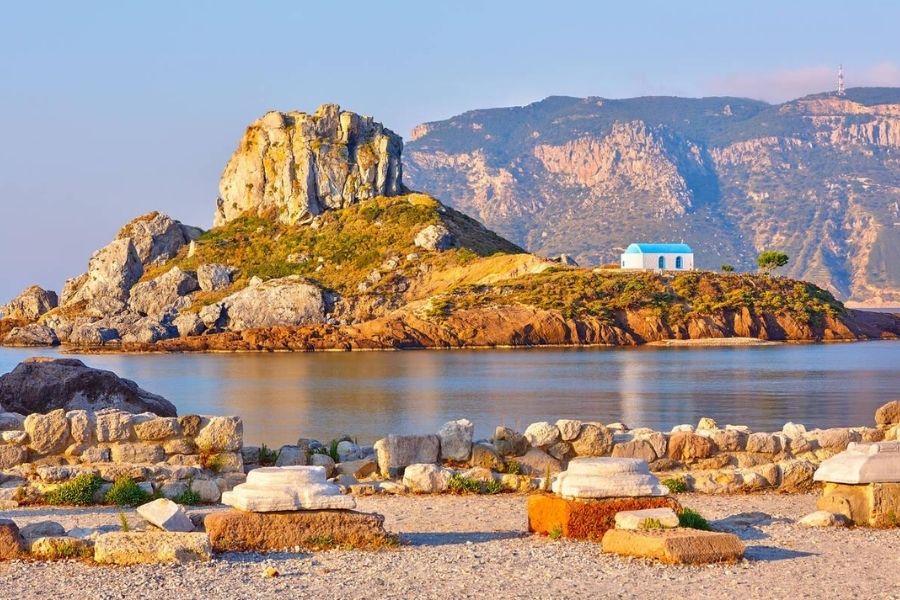
Some folks come for the Asclepion healing center, others for the sparkling waters at Paradise Beach, and plenty just want the unhurried pace of island life. Kos gives you all of it—enriching, restorative, and somehow both lively and calm at the same time.
Kos: The Healer’s Island
Kos built its reputation as a healing island thanks to its deep roots in ancient medicine and the legendary Hippocrates. You can still feel that legacy in the historic sites, the calm atmosphere, and the natural hot springs that keep drawing people looking for a reboot.
The Legacy of Hippocrates
Kos sits at the heart of medical history as the birthplace of Hippocrates, the “Father of Medicine.” Walking around, I couldn’t help but sense the weight of that legacy.
The Asclepeion of Kos stands tall as the most iconic piece of this healing tradition. You’ll find it perched on a green hill northwest of Kos Town, where it once served as both a temple to Asclepius, the god of healing, and a medical school.
Legend says Hippocrates trained right here. The Asclepeion earned its place as one of the greatest hospitals in Ancient Greece.
I found it wild that this place operated as a healing center for centuries. Patients traveled from all over the ancient world, hoping for cures that honestly sound pretty modern even now.
In Kos Town, the Tree of Hippocrates is another spot you can’t miss. This ancient plane tree is rumored to be one of the oldest in Europe.
Locals say Hippocrates himself planted it 2,400 years ago and taught his students beneath its broad branches.
Kos Town and Its Timeless Charm
Kos Town is where ancient history and modern Greek island life meet. The town sits on the northeast edge, built right on top of the old city.
This mash-up creates such a cool atmosphere. I’d be walking past Venetian mansions, then suddenly spot a traditional Greek house or stumble onto an ancient monument, all within a few blocks.
The Castle of Neratzia dominates the harbor. The Knights of Saint John built it in the 14th century, connecting it to the main town with a bridge lined by palm trees.
The castle got its name from the sour orange trees that once filled the area. Its two thick walls and four towers took more than a century to finish.
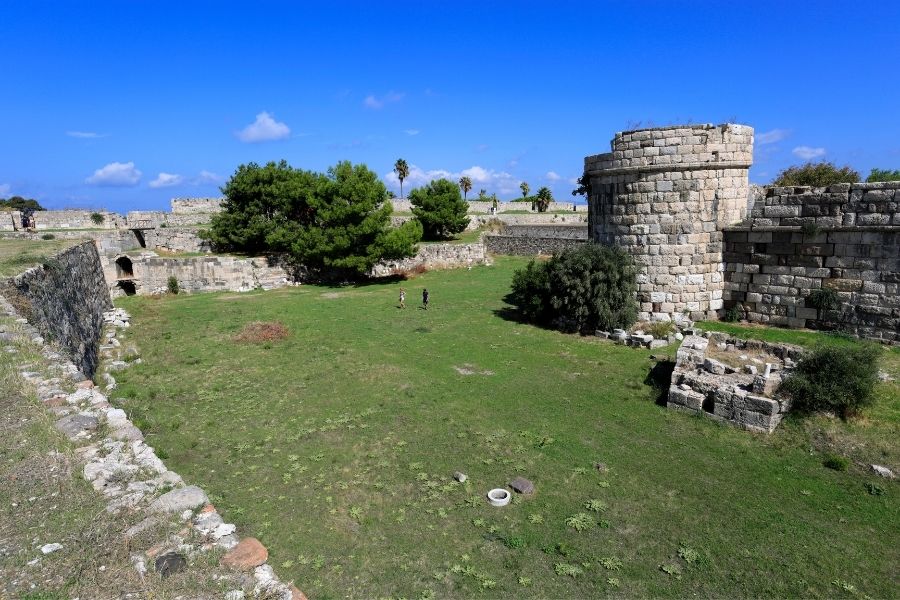
Walking Kos Town feels like time travel. The Italian influence pops up everywhere, a legacy of the 1930s occupation.
That gives Kos Town a vibe you won’t really find in other Greek island capitals.
The Archaeological Museum overflows with treasures from the island’s past. I lost track of time exploring artifacts from ancient Greece through the Roman era.
Located in the Dodecanese, Gateway to the Aegean Sea
Kos sits comfortably in the Dodecanese group, tucked into the southeastern Aegean Sea. It’s the third largest island in the chain, after Rhodes and Karpathos.
Its location made it a crossroads for centuries. You can see the layers of history left by different cultures everywhere you go.
Being in the Dodecanese means Kos connects easily to other Greek islands. Ferries run regularly to Rhodes, Patmos, and plenty of neighboring spots.
Kos lies just across from the Turkish coast, which adds another twist to its culture. That proximity shaped the island’s architecture, food, and overall personality.
I found Kos to be a perfect base for exploring the southern Aegean. The island keeps its authentic Greek charm but still has all the modern comforts you need.
The healing reputation isn’t just about history. Therma Beach, about six miles from Kos Town, has natural hot springs where people still come to soak and unwind.
The Best Sandy Beaches in Kos Island
Kos has some of the Mediterranean’s best sandy beaches, all with clear blue water and soft golden sand. Here are four beaches that really show off the island’s range—from family-friendly shallows to wild, windswept shores perfect for adventure.
Tigaki Beach: Family-Friendly Waters and Golden Sands
Tigaki Beach is just 11 kilometers west of Kos Town, so it’s super easy to reach. The golden sand stretches for miles along the north coast.
What really makes Tigaki shine is its shallow, crystal-clear waters. Kids can wade out pretty far before it gets deep, and the gentle waves are perfect for families.
You’ll find sunbeds and umbrellas for rent, plus a bunch of beach bars serving cold drinks and snacks all day long.
I loved how soft the sand felt under my feet. Even with the crowds, the beach stays impressively clean.
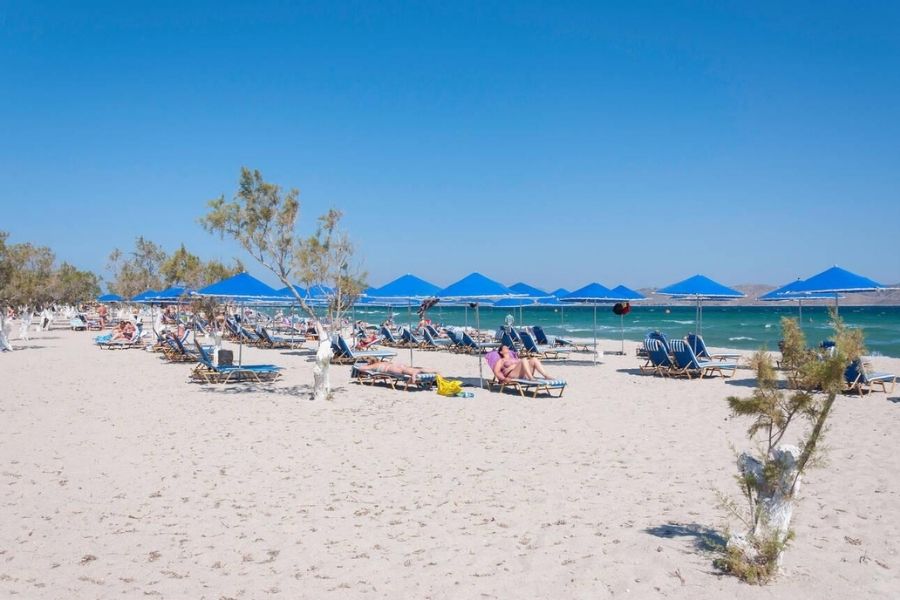
Beach Features:
- Sandy shoreline with shallow waters
- Family-friendly setup
- Quick access from Kos Town
- Plenty of beach bars and places to eat
Paradise Beach: Dreamy Ambiance and Water Sports
Paradise Beach really lives up to its name. It’s about 30 kilometers south of Kos Town, with a big sandy cove that’s both organized and wild in parts.
The clean turquoise waters and lush greenery draw in visitors, and pine trees offer shady spots along the shore.
During summer, the organized section can get busy. You can rent kayaks, paddleboards, and other water sports gear if you’re feeling active.
Since it’s on the south side, the water stays calm—great for swimming and snorkeling.
Heads up: some areas are clothing-optional, so choose your spot accordingly.
What to Expect:
- Big sandy cove with clear water
- Both organized and quiet, natural areas
- Water sports rentals on-site
- Busier in peak season
Marmari Beach: Peaceful Dunes and Natural Scenery
Marmari Beach runs along the northern coast between Tigaki and Mastichari. It’s about 20 kilometers from Kos Town and offers a quieter vibe compared to the busier beaches.
Here, you get soft white sand with low dunes and scattered greenery. The landscape stays mostly untouched, giving it a wild, natural feel.
Some parts have sunbeds and umbrellas, but other stretches are totally natural. You can pick between comfort or solitude.
The northern breeze is steady, so windsurfers love it here. The wind also keeps things cool, even in the middle of summer.
I appreciated how much space there was—even on busy days, it’s easy to find your own patch of sand.

The nearby Marmari village has tavernas dishing up fresh seafood and local favorites.
Mastichari Beach: Laid-Back Shores and Village Life
Mastichari Beach brings together lovely sandy shores and an authentic Greek island vibe. You’ll find it 27 kilometers southwest of Kos Town, right next to the fishing village of Mastichari.
The beach offers soft white sand and emerald-green waters. It’s honestly one of the most photogenic spots on the island, and the shallow water creates beautiful color changes as you look out.
Mastichari is a windsurfing hotspot, with several centers for lessons and rentals. The steady winds are great for everyone from beginners to pros.
What sets this beach apart is the village itself. Local tavernas serve fish caught by boats you’ll see bobbing in the little harbor.
Key Highlights:
- Soft white sand and emerald waters
- Top windsurfing destination
- Authentic fishing village right there
- Fresh seafood restaurants
It gets lively, but never loses its chill character. Plus, ferries to nearby islands make it a handy base for exploring.
Hidden Gems and Unique Beach Experiences
If you’re up for adventure, Kos rewards you with some coastal gems—places where ancient ruins meet the sea, a secret cove feels like your own lagoon, and wild beaches serve up epic sunsets.
Agios Stefanos Beach: Ruins by the Sea
Agios Stefanos Beach felt magical from the moment I arrived. Ancient basilica ruins sit right on the sand, making it one of Greece’s most unique beach experiences.
The 5th-century Christian basilica remains are partly underwater in the crystal-clear bay. I spent ages exploring the old stonework and mosaic bits while the waves lapped at my ankles.
What makes this beach special:
- Ancient ruins you can walk and swim around
- A small islet joined by a sandy path
- Great snorkeling with plenty of sea life
- West-facing, so the sunsets are amazing
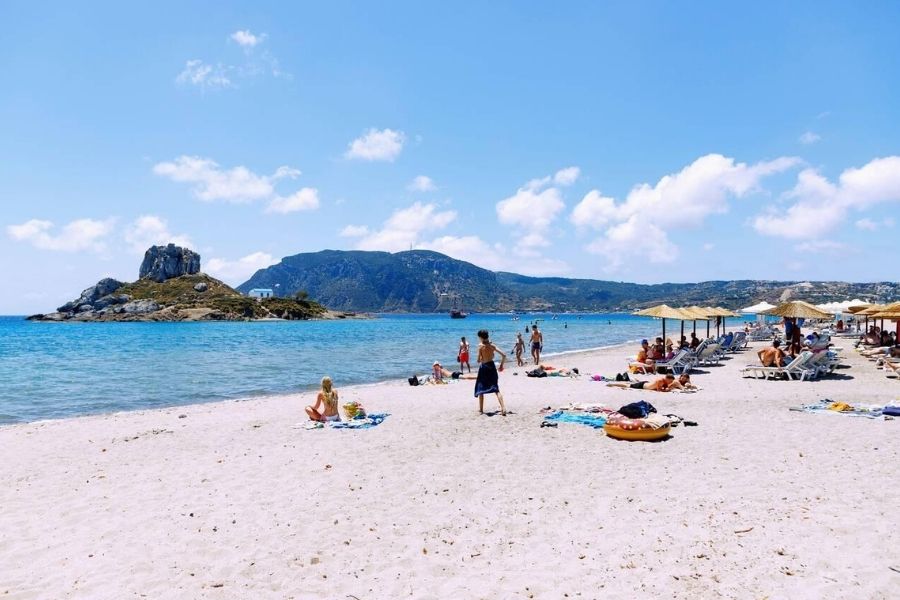
The beach is small but perfect. Golden sand, turquoise water, and a sheltered bay combine for a peaceful spot.
A simple taverna nearby serves up fresh fish and cold drinks. The owner, an older gentleman, shared stories about the ruins while I enjoyed grilled octopus with my feet in the sand.
Limnionas: Intimate Cove Near Kefalos
Limnionas feels like a secret. It’s tucked near Kefalos and you’ll need to walk about 15 minutes down a rocky path, but trust me—it’s worth every step.
Cliffs surround the cove on three sides, creating a calm, emerald-green pool that stays shallow for ages. Perfect for families with little ones.
Key features of Limnionas:
- Natural shade from overhanging rocks
- No facilities—totally unspoiled
- Protected from wind and waves
- Local fishermen sometimes drop by early in the morning
I came prepared with snacks and plenty of water. The silence was almost total—just the gentle splash of waves and the occasional seabird.
Snorkeling here is fantastic. I spotted octopus, bright fish, and sea urchins in the clear water. The rocky edges create cool underwater nooks to explore.
Agios Theologos Beach: Wild Beauty and Sunsets
Agios Theologos Beach, out on the western coast, is all about raw, wild beauty. The long golden sand faces the open Aegean, with mountains rising in the background.
Strong afternoon winds attract windsurfers and kitesurfers. I enjoyed watching their colorful sails race across the waves as I relaxed in the sand.

What to expect at Agios Theologos:
- Wide, open beach for long walks
- Consistent winds for water sports
- A few authentic tavernas close by
- Sunsets that are honestly breathtaking
The sunsets here are legendary. I watched the sun dip into the Aegean while sipping local wine at a beachside taverna, the sky blazing orange and pink.
There’s almost no development—just scattered tamarisk trees for shade and sand dunes behind the beach, adding to that wild feeling.
The Laid-Back Vibe of Kos
Kos gives off a peaceful energy that’s hard to find on Greece’s busier islands. The mountain village of Zia is a sunset lover’s dream, and seaside taverns dish up real Greek food right on the water.
Local Villages: Zia and Beyond
Zia village sits high in the hills, about 14 kilometers from Kos Town. This traditional spot has some of the most jaw-dropping sunset views I’ve seen in Greece.
Stone houses and narrow, winding streets keep the village’s old-school charm alive. Local tavernas serve classic dishes with sweeping views across the island.
What makes Zia special:
- Unbeatable sunset lookout points
- Classic Greek architecture
- Family-run restaurants with home-cooked recipes
- A peaceful, cool mountain vibe
Beyond Zia, smaller villages like Pyli and Antimachia keep the rural spirit of the island alive. Life moves slower here—locals gather in the squares for coffee and a chat.
The mountain villages offer a real escape from the coastal crowds. The air feels cooler, and the pace drops way down compared to the busy beach towns.
Seaside Taverns and Culinary Delights
Kos taverns love serving up fresh seafood and traditional Greek dishes that totally capture the island’s laid-back vibe. Here, meals stretch out for hours, usually with family or friends lingering over every bite.
I tried dolmades—those little grape leaves stuffed with rice and herbs—at a seaside spot. Locals often use old family recipes, which gives every plate its own twist.

Traditional Kos dishes to try:
- Dolmades with local herbs
- Fresh grilled octopus
- Labropites (local cheese pies)
- Honey-based desserts
Seaside taverns don’t rush you. Most places stay open late, so you might find yourself chatting long after sunset.
Fishermen haul their catch straight from the boats to the restaurants. That’s probably why the seafood tastes so fresh, and it keeps the island’s fishing traditions alive.
Slow Living: Wellness, Spas, and Hot Springs
Therma Beach’s natural hot springs create a one-of-a-kind wellness experience on Kos. Locals and visitors have soaked in these thermal waters for centuries—even Hippocrates studied here.
Therma Hot Springs spill right into the sea, so you get these warm pools tucked along the rocky shore. The water stays around 50°C, even in winter.
I found Embros Therme the easiest hot spring to reach. There’s something magical about drifting between the hot water and the cool sea—a real natural spa.
Benefits of Kos thermal springs:
- Natural mineral content
- Therapeutic properties
- Free access to most springs
- Beautiful coastal settings
Modern spas blend these ancient healing traditions with today’s treatments. Many hotels offer massages or meditation rooms if you want to unwind indoors.
Wellness on Kos isn’t just about spas. Beach time, slow meals, and lazy afternoon naps are basically essential here.
Exploring Culture, Nature, and Nearby Adventures
Kos brings together ancient healing sites, outdoor adventures across wild landscapes, and easy ferry rides to neighboring islands, each with its own quirks and charm.
Asklepion: Sacred Healing Grounds
The Asklepion stands out as Kos’s most famous cultural site. You’ll find this ancient healing center about 4 kilometers southwest of Kos town, spread over three terraced levels.
I wandered through marble staircases built between the 4th and 2nd centuries BC. The ruins replaced an even older sanctuary from Hippocrates’ era in the 5th century BC.
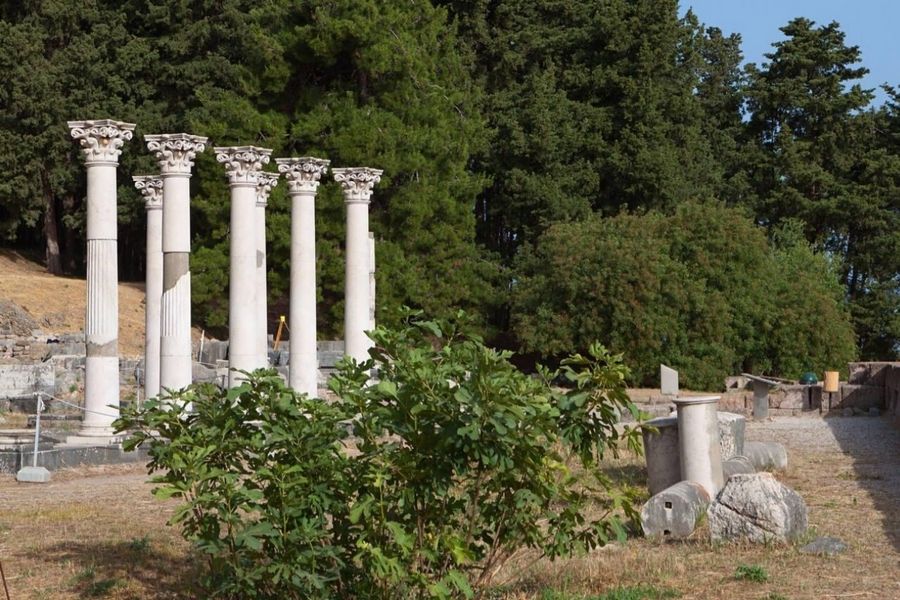
The three levels include:
- Lower level: Monumental entrance and Roman baths
- Middle level: Altar to Asclepius and sacred cypress forest
- Upper level: Doric Temple of Asclepius
Ancient Greeks dedicated the site to Asclepius, god of healing. People came here for cures that mixed medicine and spiritual rituals.
I walked among ruins where early medicine took shape. The abaton once hosted the most mysterious healing ceremonies.
Nearby, the Hippocrates Foundation planted gardens with medicinal herbs. These plants gave me a glimpse of the herbal wisdom Hippocrates once used.
Nature and Outdoor Activities
Kos has a 13-kilometer cycling path along the waterfront in the main town. I pedaled down Finikas Avenue, past Neratzia Castle, and through quiet backstreets.
The island’s flat terrain makes cycling a breeze for pretty much anyone. I often rode between beach towns and villages without breaking a sweat.
Popular outdoor activities include:
- Cycling tours through villages like Zia and Asfendiou
- Beach hopping along 40 kilometers of coastline
- Hiking on Mount Dikeos slopes
- Water sports at organized beaches
Tigaki, Marmari, and Mastichari beaches offer windsurfing and plenty of water sports. Mastichari, in particular, gets steady winds—perfect for windsurfing.
Plaka pine forest has hiking trails where peacocks strut around like they own the place. Villages like Antimachia show off traditional architecture and local customs.
Wine tours lead you to vineyards on Mount Dikeos’s limestone slopes. I sampled Assyrtiko and other local wines at a few small wineries east of town.
Day Trips to Kalymnos, Nisyros, and Santorini
Boats leave Kos Marina for several Dodecanese islands, and you can reach most within a couple of hours. I hopped on day trips just to see what surprises each island had in store.
Kalymnos sits only 12 kilometers north of Kos. The island’s known for sponge diving and dramatic rock climbing. Ferries from Mastichari get you there in about 20 minutes.
I checked out the sponge diving museum and watched climbers tackle the cliffs. Locals still harvest natural sponges using age-old methods.

Nisyros features active volcanic landscapes just 16 kilometers south of Kos. Day trips take you to the crater and villages like Nikia.
Walking around the volcanic crater, I could actually feel the heat rising from the ground. The island’s black sand beaches and pumice stone are pretty unique.
Santorini is farther away—3 to 4 hours by ferry—but you get those famous sunsets. Some tours run day trips in summer, though I’d stay overnight if you can.
Pserimos, a tiny island opposite Kos, offers quiet beaches and simple pleasures. Most boat tours here include lunch and plenty of swim stops.
Essential Travel Tips for a Stress-Free Escape
A little planning goes a long way on Kos. Mild weather runs from April to October, and getting around by bike or bus keeps things simple and affordable.
Best Time to Visit Kos
May through September hits that sweet spot of warm weather and manageable crowds. July and August get hot—up to 85°F—but the beaches are at their best.
Spring, especially April and May, brings mild temperatures around 70°F. The island’s noticeably quieter and hotels drop their prices. I loved wandering around without the summer crowds or heat.
September and early October are honestly my favorite. The sea’s still warm, but the crowds have thinned out. Evenings feel just right for outdoor dinners.
Most hotels and restaurants close in winter. Ferries run less often, so island hopping becomes tricky. Unless you crave total solitude, I’d skip November through March.
Getting Around: Biking, Buses, and Ferries
Renting a bike became my go-to way to see Kos. The island’s flat, so cycling is easy for just about everyone. Bike rental shops cluster in Kos Town and usually charge around €10 a day.
Local buses run reliably between major towns and beaches. The KTEL system gets you to Kardamena, Kefalos, and Mastichari several times a day. Fares range from €2 to €4 depending on distance.
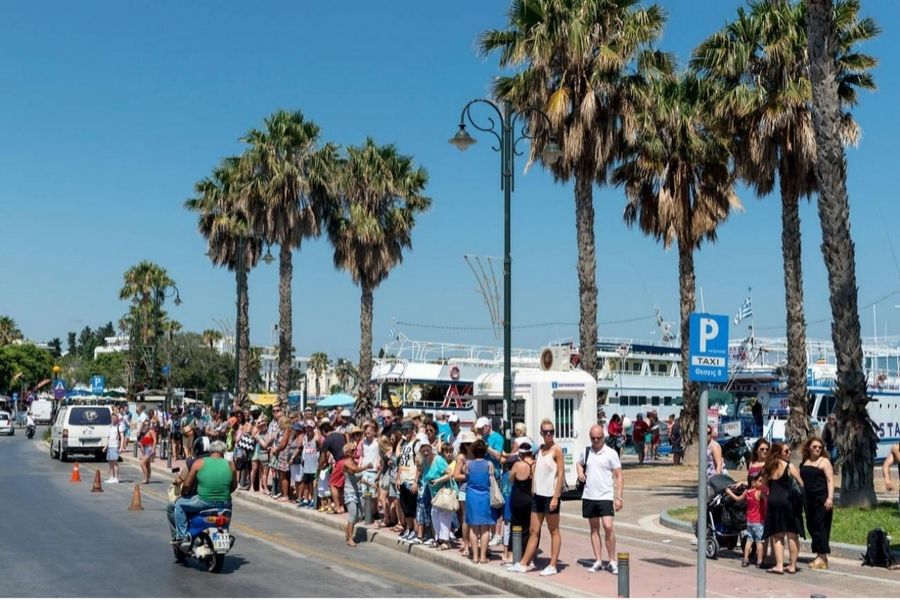
Bus Routes I Used Most:
- Kos Town to Kardamena (30 minutes)
- Kos Town to Psalidi Beach (15 minutes)
- Kos Town to Tigaki Beach (20 minutes)
You can rent a car if you want total freedom, but it’s not essential. Agencies operate at the airport and in town, and parking’s mostly free outside Kos Town center.
Where to Stay for a Relaxed Getaway
Kos Town puts you right in the action, close to restaurants, bars, and the ferry port. I stayed in a cozy hotel near the harbor and walked everywhere. Prices usually run €40-80 per night for a decent room.
Kardamena’s all about beach access without too much city noise. This resort town sits right on the sand, with lots of family-friendly hotels and good food spots.
My Top Location Picks:
- Kos Town: Best for nightlife and ferry connections
- Kardamena: Perfect for beach lovers and families
- Kefalos: Quietest option with stunning sunsets
- Tigaki: Great beaches with easy bus connections
Northern areas like Tigaki and Marmari have wide, sandy beaches and a peaceful vibe. They’re perfect if you want a laid-back base but still want to pop into busier spots now and then.
Frequently Asked Questions
Planning a Kos trip means figuring out where to stay, what to see, and how to get around. I’ve pulled together answers to the questions I hear most from travelers.
What are the top attractions to visit on the island of Kos?
Start with the Asklepion, the ancient sanctuary dedicated to Hippocrates. The ruins sit on a hillside with sweeping views of the Turkish coast.
Check out the Castle of Neratzia in Kos Town. Built by the Knights of St. John, it stands guard over the harbor and makes for great photos.
Paradise Beach on the southern coast is famous for its long, golden sands. The water’s usually calm—ideal for swimming or just unwinding.
I always stop by the Plane Tree of Hippocrates in the town center. Legend says Hippocrates taught his students beneath its branches.
Zia village is my go-to for sunset views. It’s up in the mountains, with traditional tavernas and local craft shops.
Can you recommend unique activities to experience in Kos?
Cycling is a must—Kos is called the bicycle island for a reason. The flat terrain and bike paths make it easy to hop between beaches and villages.
Take a boat to Nisyros to see an active volcano. Day trips leave regularly from Kardamena in the summer.
The hot springs at Therma Beach offer a natural spa right by the sea. Warm sulfur water flows straight into the ocean, creating these dreamy pools.
Try horse riding in the interior valleys for a new perspective. Several stables cater to both beginners and experienced riders.
Windsurfing at Mastichari Beach is a blast, thanks to the steady winds. You can rent gear or book lessons right on the sand.
Which areas in Kos offer the best accommodations for tourists?
Kos Town has the most hotel options and puts you close to restaurants, shops, and nightlife. It’s a great base for first-timers.
Kardamena draws younger travelers with its beach clubs and party scene. Lots of all-inclusive hotels sit right on the sand.
Mastichari is quieter, with family-friendly hotels and relaxed tavernas. The beach here never feels too crowded.
Kefalos Bay in the southwest is where you’ll find luxury resorts and private beaches. Couples looking for a peaceful, upscale escape should check it out.
Tigaki is perfect for long sandy beaches without the chaos. Several mid-range hotels line this part of the coast.
How can I explore Kos if I only have one day on the island?
Rent a car or scooter early in the morning to make the most of your day. Start in Kos Town to see the Castle of Neratzia and the Plane Tree of Hippocrates.
Head to the Asklepion next—it’s a quick drive, and the ruins are especially beautiful in the morning light.
Stop in Zia village for lunch and mountain views. The drive from the Asklepion takes about 20 minutes.
Spend your afternoon at Paradise Beach or Tigaki Beach. Both offer sun loungers, tavernas, and plenty of space to relax.
Finish your day back in Kos Town for dinner and drinks by the harbor. The waterfront really comes alive after sunset.
Are there any historical sites related to Hippocrates on Kos?
The Asklepion is the main site tied to Hippocrates. This ancient medical school and healing center dates back to the 4th century BC.
I always walk the three terraced levels to get a sense of how ancient medicine worked. You’ll see temples, treatment rooms, and patient quarters.
The Plane Tree of Hippocrates in Kos Town’s main square marks where he supposedly taught. The current tree isn’t ancient, but it’s said to grow from the original roots.
The Archaeological Museum in Kos Town displays medical instruments and inscriptions from the Hippocratic era. Several exhibits explain how ancient healing worked.
Casa Romana, though not directly linked to Hippocrates, shows how wealthy Greeks lived back in the day. The restored villa has lovely mosaics and frescoes.
What are the best options for getting around Kos by car?
Honestly, I always try to book a rental car ahead of time—especially if I’m heading to Kos in the summer. The demand just skyrockets, and it’s no fun scrambling for a car at the last minute.
You’ll find several big-name rental companies right at the airport and scattered around Kos Town. Super convenient, really.
A main coastal road loops around the whole island, connecting all the big beaches and those charming little villages. I find the roads pretty reliable; most are smooth, and the signs are easy to follow, both in Greek and English.
Parking in Kos Town? Well, it can be a headache during busy hours. I usually go for the free parking by the marina or just pick a hotel that includes parking—makes life easier.
Gas stations pop up in every major town, so you won’t be stranded. Still, I like to top up before driving off to the quieter corners of the island. Most places take credit cards, and they usually stay open until the evening.
If you’re tempted to visit mountain villages like Zia, the roads get a bit tight and twisty, but they’re paved. Just take it slow, and keep an eye out for those big tour buses barreling around the bends.

